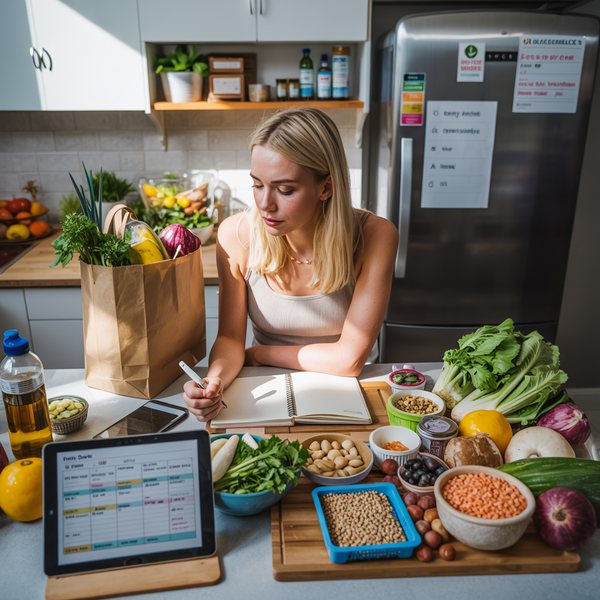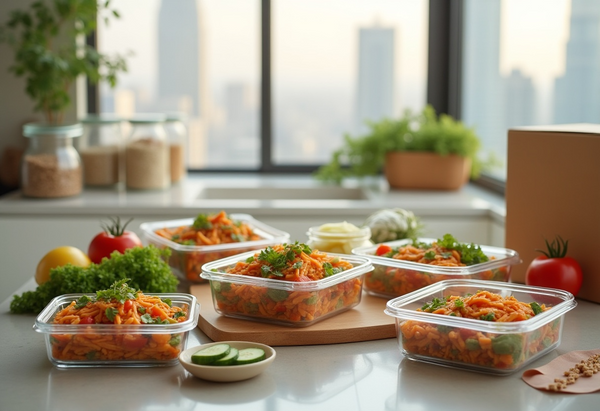Overcoming Challenges in a Vegan Lifestyle with Meal Planning
by JUSTINE YOLANDA

Adopting a vegan lifestyle is a powerful choice for your health, the environment, and animal welfare. But while the benefits are well-documented, the transition isn’t always smooth. Many new vegans quickly discover that enthusiasm alone isn’t enough to sustain the change long term.
From dealing with nutrient gaps to the constant question of “what do I eat next?”, the early stages of a vegan diet often come with unexpected roadblocks. You might find yourself struggling to get enough protein, unsure how to replace key nutrients like B12 or iron, or feeling isolated at social gatherings where plant-based options are limited. Some face food fatigue eating the same meals on repeat while others simply lack the time or structure to plan ahead.
The good news? These challenges aren’t signs that veganism is too hard, they're signs that you need a smarter system. That system is meal planning.
When done right, vegan meal planning eliminates the guesswork, balances your nutrition, and makes staying on track feel effortless. Whether you're new to plant-based eating or trying to get more consistent, learning how to plan your meals is one of the most effective ways to stay nourished, energized, and motivated.
In this guide, we’ll break down the most common struggles of a vegan lifestyle and show you exactly how meal planning helps you overcome them.
Why People Struggle With a Vegan Diet
Switching to a vegan diet often starts with excitement but it can quickly be met with confusion, overwhelm, or even burnout. While the core principles of veganism are simple, the practical day-to-day execution is where many people begin to struggle.
Nutritional confusion is one of the most common pain points. There’s a flood of conflicting advice online — some say you need supplements, others push raw-only eating, while others suggest plant-based processed alternatives are fine. Many people don’t know how to meet key nutritional needs like protein, vitamin B12, iron, omega-3s, or calcium through a plant-based diet. The result? Fatigue, cravings, or eventually giving up altogether.
Then there’s social and family pressure. Eating out with friends, going to family dinners, or even just explaining your food choices at work can be awkward or worse, isolating. When support systems aren't aligned, it’s easy to feel like the "difficult" one, making it tempting to compromise your values or skip meals altogether.
Affordability and accessibility also play a major role. While beans and rice are cheap staples, many perceive vegan diets as expensive due to the cost of specialty products like dairy alternatives or mock meats. And depending on where you live, basic vegan ingredients may not be readily available.
Most significantly, many new vegans lack a structured routine around food. Without meal prep habits or a grocery strategy, it’s easy to fall back on carbs and processed snacks, leading to diet fatigue or poor results. Add emotional eating or stress into the mix, and the initial motivation can quickly fizzle out.
Ultimately, these struggles don’t mean veganism is too difficult, they mean you need a better system. That’s where intentional meal planning steps in: to eliminate guesswork, simplify your routine, and make your plant-based diet sustainable for the long haul.
Common Nutritional Challenges in a Vegan Diet
Adopting a vegan lifestyle can be a powerful step toward better health and sustainability—but only when done right. Without strategic planning, nutritional pitfalls are common. From protein myths to micronutrient deficiencies, understanding these challenges is critical for long-term success.
1. Protein Intake Misconceptions
The myth that vegans can’t get enough protein persists even though it’s entirely possible through plants. The issue isn’t availability, but awareness. Many new vegans overlook complete protein sources, or under-eat in general, leading to muscle loss, low energy, or hunger between meals.
Solution: Combine a variety of plant proteins daily like lentils, tofu, tempeh, quinoa, chickpeas, and hemp seeds. According to the Vegan Society, aiming for 0.8–1.0 grams of protein per kg of body weight is typically sufficient for the average adult, though athletes may need more.
2. B12 Deficiency
Vitamin B12 is vital for brain function, energy metabolism, and red blood cell production. It’s not naturally present in plants, and deficiency can lead to fatigue, memory issues, and nerve damage over time.
Solution: Take a reliable B12 supplement (cyanocobalamin form is highly bioavailable) or eat fortified foods like plant-based milks, breakfast cereals, or nutritional yeast. Harvard Health recommends 2.4 mcg daily for adults.
3. Iron and Zinc Deficiencies
Plant-based iron (non-heme iron) isn’t as easily absorbed as animal-derived heme iron. Zinc absorption from plants is also limited due to phytates. This can lead to fatigue, weakened immunity, or poor recovery.
Solution: Eat iron-rich foods like lentils, pumpkin seeds, tofu, and dark leafy greens paired with vitamin C (like citrus or bell peppers) to enhance absorption. For zinc, prioritize foods like beans, oats, cashews, and tahini. In high-demand situations, a supplement may be beneficial.
4. Omega-3 Fatty Acids
EPA and DHA (found in fish) are crucial for brain health and inflammation control, but they’re missing from most vegan diets.
Solution: Include ground flaxseeds, chia seeds, walnuts, and algae-based DHA/EPA supplements. Algae oil is a direct, vegan-friendly source of omega-3s, recommended by plant-based nutritionists.
5. Calcium and Bone Health
Without dairy, calcium intake can drop, raising long-term bone health concerns.
Solution: Eat calcium-set tofu, fortified plant milks, almonds, broccoli, and leafy greens like kale or bok choy. The National Institutes of Health recommends 1,000 mg/day for most adults.
When these nutrients are overlooked, symptoms like low energy, frequent cravings, poor mood, and plateaued progress become common. But with thoughtful planning and the right food choices, these risks are completely manageable.
Meal planning eliminates the guesswork helping you meet all your nutritional needs, stay energized, and thrive on a vegan diet.
Reduces Chances of Giving Up During High-Stress Weeks
Most people abandon a vegan diet not due to lack of motivation but due to burnout. When stress peaks, poor planning leads to skipped meals, poor nutrition, or emotional eating.
Meal planning acts as a safety net:
-
Prepped meals are ready even when life gets chaotic
-
You’re less likely to “cheat” or quit due to hunger or frustration
-
You maintain stability during emotionally tough periods
Think of it as meal insurance—protecting your progress.
Example: 3-Day Simple Vegan Meal Plan Template
Here’s a basic structure anyone can adapt or build on:
Day 1
-
Breakfast: Overnight oats with chia seeds, almond milk, banana, and peanut butter
-
Lunch: Chickpea salad wrap with tahini dressing and mixed greens
-
Dinner: Lentil curry with brown rice and steamed broccoli
-
Snack: Apple with almond butter
Day 2
-
Breakfast: Tofu scramble with spinach, peppers, and whole grain toast
-
Lunch: Quinoa bowl with black beans, corn, avocado, and salsa
-
Dinner: Vegan stir-fry with tempeh, veggies, and soba noodles
-
Snack: Carrot sticks and hummus
Day 3
-
Breakfast: Green smoothie (spinach, banana, flaxseeds, oat milk, protein powder)
-
Lunch: Vegan wrap with hummus, cucumber, olives, tomato, and sprouts
-
Dinner: Baked sweet potato with roasted chickpeas and tahini drizzle
-
Snack: Mixed nuts and a square of dark chocolate
This simple approach prevents nutrient gaps, keeps meals exciting, and sets a strong foundation for anyone serious about succeeding on a vegan lifestyle.
Seven Smart Vegan Meal Planning Tips
Staying consistent on a vegan diet isn’t just about choosing the right foods—it’s about systematizing how you think about nutrition, energy, and time. These seven smart meal planning tips will help you sustain a balanced, exciting, and results-driven vegan lifestyle.
1. Plan Protein Sources in Every Meal
Protein is the nutrient most people worry about when going vegan—and for good reason. While plant-based protein sources are abundant, they need to be intentionally included.
Your strategy:
-
Include legumes (chickpeas, lentils, black beans), tofu, tempeh, or seitan in lunches and dinners
-
Add hemp seeds, chia seeds, or plant-based protein powder to breakfasts and smoothies
-
Don’t rely solely on carbs like pasta or bread—pair them with protein-rich toppings or sides
Planning protein across the day supports muscle repair, energy levels, and appetite control.
2. Rotate Greens, Grains, and Legumes to Avoid Monotony
Monotony leads to boredom, which often leads to falling off the diet. Variety in meal planning is more than a luxury; it's a tool to sustain motivation.
How to rotate effectively:
-
Alternate between leafy greens (spinach, kale, arugula), cruciferous vegetables, and colorful veggies
-
Switch between grains: quinoa, brown rice, bulgur, oats, barley, millet
-
Use different legumes each week to vary flavor and micronutrient intake
Rotating ingredients also supports gut health and provides a broader range of nutrients.
3. Use Batch Cooking for Efficiency
Batch cooking eliminates the “daily grind” of cooking from scratch and ensures that healthy food is always within reach.
How to do it right:
-
Cook large portions of staples like lentils, beans, rice, or roasted vegetables on weekends
-
Store portions in airtight containers to mix and match meals throughout the week
-
Prep sauces (like tahini, pesto, or peanut-based dressings) to quickly elevate dishes
Even just 2–3 hours of prep each week can save you 10+ hours and prevent impulse food choices.
4. Incorporate Fortified Foods Into Your Routine
While whole foods should form the base of your diet, fortified vegan products play a key role in bridging nutritional gaps.
Key fortified foods to include:
-
Plant milks with added calcium and vitamin D
-
Nutritional yeast fortified with vitamin B12
-
Breakfast cereals or meat alternatives with added iron and zinc
Planning a few servings of fortified items each week makes your diet stronger and more complete.
5. Supplement With Essentials (B12, DHA, etc.)
No matter how healthy or varied your plant-based meals are, some nutrients are difficult to get through food alone. This is where targeted supplementation comes in.
Essential vegan supplements to consider:
-
Vitamin B12 – crucial for nerve function and energy
-
Vitamin D – especially in winter or low-sun environments
-
Omega-3s (DHA/EPA) – sourced from algae oil for brain and heart health
-
Iron or iodine – as needed, based on blood work or diet gaps
Integrate supplementation into your weekly plan just like meals—it’s part of nutritional insurance.
6. Plan Calorie-Dense Snacks to Stay Energized
Many new vegans underestimate how many calories they need—especially if they come from a high-fat, omnivorous diet. The result? Constant hunger, low energy, and snacking on junk.
Smart vegan snacks include:
-
Trail mix with nuts, seeds, and dried fruit
-
Nut butters on toast or apple slices
-
Energy balls made with oats, dates, and cacao
-
Roasted chickpeas or hummus with crackers
Build these into your plan to prevent fatigue and stay satisfied between meals.
Use Digital Tools or Printable Templates for Structure
Planning doesn’t need to be complex or time-consuming. Digital tools and templates can automate much of the process and keep you accountable.
Use tools like:
-
Google Sheets or Notion for your weekly meal calendar
-
Apps like Cronometer or MyFitnessPal to check nutrient levels
-
Printable meal plan + grocery list templates for easy offline tracking
Templates provide structure; digital tools offer flexibility. Use both to create a system that works for you.
By applying these seven meal planning strategies, you build more than just a food plan—you build resilience, balance, and sustainability into your vegan lifestyle. This is how long-term success is achieved.
Real-Life Lifestyle Challenges and How to Deal with Them
Adopting a vegan lifestyle is one thing. Sticking to it in the real world surrounded by social events, travel, stress, and skeptics is a whole different challenge. Here’s how to navigate common roadblocks without losing momentum.
Eating Out and Navigating Restaurants
One of the top concerns for vegans is what to eat when dining out. While the restaurant scene is improving, vegan options can still be limited or misunderstood.
Strategy:
-
Look up menus ahead of time
-
Don’t hesitate to call and ask about customization
-
Stick with cuisines that naturally have vegan staples (Indian, Middle Eastern, Thai)
Being proactive reduces anxiety and keeps you in control of your choices.
Managing Cravings and Emotional Eating
Cravings especially for high-fat or nostalgic foods can feel overwhelming. They’re often more emotional than physical.
Solution:
-
Plan satisfying comfort meals using vegan alternatives (mac and “cheese,” burgers, desserts)
-
Don’t under-eat during the day undereating triggers late-night cravings
-
Use non-food tools like walking, journaling, or calling a friend when stress hits
Preparedness kills temptation. Make sure your environment supports your intentions.
Handling Family Members Who Are Not Vegan
Family pressure or judgment can be one of the hardest things to manage, especially during holidays or gatherings.
Approach:
-
Don’t try to convert people focus on your own choices
-
Offer to bring a dish or two that everyone can try
-
Lead by example: energy, consistency, and positive attitude often speak louder than words
Respect is a two-way street. Stay firm but kind.
Dealing with Travel or Workplace Meals
When you’re away from home, your control over food drops—but that doesn’t mean you’re powerless.
Plan ahead:
-
Bring vegan snacks and protein bars
-
Research vegan-friendly spots near your hotel or office
-
Use meal delivery apps to your advantage
For longer trips, consider renting a place with a kitchen.
Conclusion
Adopting a vegan lifestyle comes with its fair share of challenges, nutritional concerns, social friction, emotional eating, and the everyday stress of figuring out what to eat. But the good news? These hurdles are entirely manageable with the right strategy in place.
Consistent, thoughtful meal plans are the anchor that holds everything together. It simplifies your day-to-day decisions, ensures nutritional balance, helps avoid burnout, and gives you confidence to stay the course even when life gets busy or others question your choices.
You don’t need to be perfect. You just need a system.
Start by taking one step: planning your next three days of meals. Don’t wait until you “feel ready” clarity and momentum come from action.




